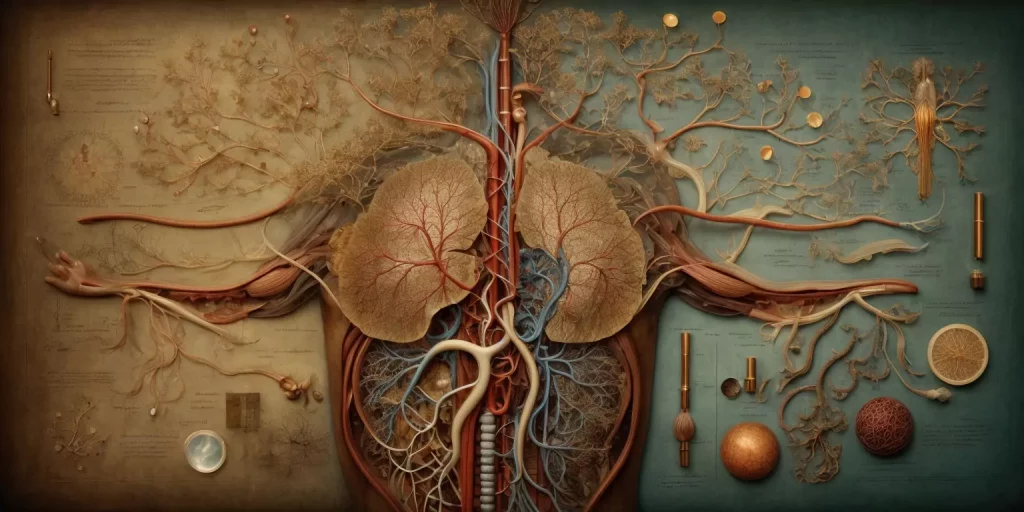Are you ready to delve into the fascinating world of the 5 Elements Theory? This ancient philosophy, which is deeply ingrained in Chinese culture and medicine, provides a distinct viewpoint on the interconnectedness of life and the universe.
So what is the 5 Elements Theory? Let’s get ready to explore this enlightening journey and gain a better understanding of what this theory entails.
The 5 Elements Theory is a fundamental concept in Traditional Chinese Medicine (TCM), rooted in an ancient Chinese philosophy that believes wood, fire, earth, metal, and water are fundamental elements of life and the universe, all interconnected and influencing each other.
There is so much to discover about the Five Elements Theory. Keep reading to explore this intriguing subject further.
- Understanding the Essence of the 5 Elements Theory
- TCM 5 Elements Theory: Exploring the Concept
- Practical Applications for Health and Well-being
- Optimizing Health with the 5 Elements Theory
- Implementing the 5 Element Theory in Diet and Exercise
- Embracing Balance and Harmony
- Exploring the Theory of Connection and Interaction in the Five Elements
- Nurturing Your Nervous System: The Five Major Organ Systems and the Five Elements
- Exploring the Connection Between the Five Elements and Personality
- Discover Your Elemental Type: Which Element Are You?
- Conclusion: Understanding the Essence of the 5 Elements Theory
- FAQs
Understanding the Essence of the 5 Elements Theory
The 5 Elements Theory in Traditional Chinese Medicine (TCM) emphasizes balancing yin and yang energy flow, harmonizing the body and mind, and promoting overall well-being. It specifically addresses qi (life force or vital energy) imbalances in people. By recognizing the elemental qualities of the five elements (wu xing) within ourselves, we can better understand our constitutional element and its impact on our health according to Traditional Chinese Medicine (TCM).
Balancing energy flow
In the theory of Wuxing in Traditional Chinese Medicine, each element represents different aspects of nature and has specific characteristics associated with it. The meridian system and the concept of qi are integral to understanding this theory.
These elements include Wood, Fire, Earth, Metal, and Water. Each element in the Wuxing system of Traditional Chinese Medicine (TCM) is connected to certain organs in the body, and corresponds to different emotions and physical traits along the meridian system.
The goal in Traditional Chinese Medicine (TCM) is to maintain a balance between the five elements, known as wu xing, to ensure smooth energy flow throughout the body’s meridian system.
Harmonizing body and mind
By understanding the 5 Elements Theory, individuals can identify imbalances within their qi and meridian system and take steps to restore harmony. For example, in Traditional Chinese Medicine (TCM), if someone has an excess of Fire element energy in their meridian system, they may experience symptoms such as restlessness or anxiety due to an imbalance in their qi.
Recognizing this imbalance in the child element according to the TCM and element framework allows them to focus on activities or practices that promote grounding and calming effects, in line with the principles of wu xing.
Promoting overall well-being
The 5 Elements Theory, a key concept in Traditional Chinese Medicine (TCM), provides a holistic approach to well-being by addressing both physical and emotional aspects through the meridian system.
By understanding their constitutional element in the context of TCM and the meridian system, individuals can make lifestyle choices that support their unique needs. For instance, someone with a Wood element constitution in Traditional Chinese Medicine (TCM) might benefit from incorporating more movement or exercise into their routine to support their overall system.
Recognizing elemental qualities
Each constitutional element in Traditional Chinese Medicine (TCM) has its own set of qualities that can influence an individual’s personality traits and preferences. By recognizing these elemental qualities within themselves and others, people can develop greater empathy and understanding for different perspectives in the context of Traditional Chinese Medicine (TCM).
TCM 5 Elements Theory: Exploring the Concept

The TCM 5 Elements Theory is based on the foundation of the Yin-Yang theory. It explores the interplay between opposing forces in TCM’s element theory and how they create balance within our bodies using the element framework. This theory, known as Traditional Chinese Medicine (TCM), also emphasizes the correspondence between each element and specific seasons and organs in our body.
Each element in Traditional Chinese Medicine (TCM) theory has its own unique characteristics and qualities. For example, in the element framework, Wood represents growth and expansion, while Fire symbolizes warmth and passion.
These elemental characteristics are essential for understanding the tcm and constitutional element theories. In Traditional Chinese Medicine (TCM), the element theory is an essential concept. Each constitutional element, such as Earth, Metal, and Water, represents different qualities in The Five Elements Theory Cycle.
These elements are also associated with the 5 Elements Meridians. Earth embodies stability and nourishment, Metal signifies strength and clarity, and Water represents fluidity and adaptability.
In Traditional Chinese Medicine (TCM), energy flows through constitutional elements known as meridians or pathways in our body. These meridians are part of the Control (Ke) Cycle. These TCM meridians correspond to different organs, emotions, seasons, and elements. The balance of these elements is crucial for maintaining good health in TCM.
Let’s take a closer look at how each element in Traditional Chinese Medicine (TCM) corresponds to specific seasons and organs.
Correspondence with Seasons:
- Wood: Spring
- Fire: Summer
- Earth: Late summer
- Metal: Autumn
- Water: Winter
Correspondence with Organs:
- Wood: Liver and Gallbladder
- Fire: Heart, Small Intestine, Pericardium, Triple Burner
- Earth: Spleen, Stomach
- Metal: Lung, Large Intestine
- Water: Kidney, Bladder
Understanding these correspondences can help us identify imbalances within our bodies, according to Traditional Chinese Medicine (TCM). TCM recognizes that each individual has a unique constitutional element. By addressing these imbalances through TCM practices such as acupuncture, herbal medicine, or lifestyle changes such as diet or exercise modifications, we can restore harmony to our overall well-being.
Practical Applications for Health and Well-being

Identifying imbalances through symptoms
One practical application of the TCM 5 Elements Theory is using it to identify imbalances in the body by paying attention to specific symptoms. For example, if someone frequently experiences digestive issues like bloating or constipation, it could indicate an imbalance in the Earth element according to TCM. On the other hand, recurring skin problems may point to an imbalance in the TCM Metal element. By recognizing these patterns, individuals can gain insight into their health issues and take appropriate action.
Tailoring treatments based on elemental diagnosis
Once imbalances are identified, treatments can be tailored based on elemental diagnosis. This involves using various methods such as acupuncture, herbal medicine, dietary adjustments, and lifestyle changes to restore balance within the elements. For instance, if someone has excessive heat-related symptoms like hot flashes or irritability (indicative of a Fire element imbalance), they may be advised to avoid spicy foods and engage in calming activities like meditation.
Addressing root causes rather than symptoms alone
Unlike conventional medicine which often focuses solely on alleviating symptoms, the 5 Elements Theory emphasizes addressing the root causes of health issues. By understanding which element is out of balance and causing specific symptoms, individuals can target the underlying problem instead of just treating surface-level manifestations. This holistic approach aims to bring about long-lasting improvements in overall well-being.
Enhancing vitality and resilience
By incorporating the principles of the 5 Elements Theory into their lives, individuals can enhance their vitality and resilience. The theory suggests that each element corresponds not only to physical aspects but also to emotional and mental attributes. By nurturing all five elements through appropriate foods, work-life balance, activity levels, and self-care practices aligned with one’s elemental constitution, people can optimize their health and well-being.
Optimizing Health with the 5 Elements Theory
The 5 Elements Theory offers a unique perspective on optimizing health and well-being. By aligning lifestyle choices with elemental qualities, individuals can create balance in their daily routines and activities. This theory recognizes that each element—Wood, Fire, Earth, Metal, and Water—represents specific traits and characteristics that influence our physical and emotional well-being.
Aligning Lifestyle Choices with Elemental Qualities
One way to optimize health using the 5 Elements Theory is by aligning lifestyle choices with the elemental qualities associated with each element. For example:
- Wood: Emphasize growth, flexibility, and movement by engaging in regular exercise or trying new activities.
- Fire: Foster joy, passion, and connection through social interactions or pursuing creative endeavors.
- Earth: Cultivate stability, nourishment, and grounding by focusing on balanced nutrition and creating a supportive environment.
- Metal: Promote clarity, organization, and discipline by practicing mindfulness techniques or decluttering your living space.
- Water: Foster introspection, adaptability, and relaxation through activities like meditation or spending time near bodies of water.
Creating Balance in Daily Routines and Activities
Another key aspect of the 5 Elements Theory is recognizing the importance of balance in our daily routines. By incorporating elements from each category into our lives in appropriate amounts, we can promote overall well-being. Here are some ways to achieve this balance:
- Wood Element: Engage in physical activities while also allowing time for rest and recovery.
- Fire Element: Seek moments of excitement and passion while also ensuring sufficient rest to avoid burnout.
- Earth Element: Prioritize self-care practices alongside responsibilities to maintain a sense of stability.
- Metal Element: Balance structure and routine with moments of spontaneity to foster creativity.
- Water Element: Incorporate moments of reflection and introspection to cultivate a sense of wisdom and adaptability.
Implementing the 5 Element Theory in Diet and Exercise

To optimize health and well-being, it is important to implement the principles of the 5 Element Theory in our diet and exercise routines. By understanding our elemental needs, we can make dietary choices that support balance and harmony within our bodies.
Dietary recommendations based on elemental needs
Each element – Wood, Fire, Earth, Metal, and Water – corresponds to specific organs and bodily functions in The Five Elements Theory Cycle. These elements are also associated with the 5 Elements Meridians. To nourish these elements, we can incorporate foods that align with their attributes:
- Wood: Include foods like leafy greens, sprouts, and sour fruits to support liver function.
- Fire: Opt for spicy foods, red-colored fruits and vegetables, and bitter herbs to enhance heart health.
- Earth: Focus on root vegetables, whole grains, legumes, and sweet-tasting foods to strengthen digestion.
- Metal: Incorporate pungent flavors like onions, and garlic; white-colored foods such as cauliflower or radishes to promote lung health.
- Water: Consume sea vegetables, and black beans; salty or umami flavors to nourish the kidneys.
Customized exercise routines for each element
Just as different elements have unique dietary requirements, they also benefit from specific types of physical activity:
- Wood: Engage in activities that promote flexibility and stimulate circulation such as yoga or tai chi.
- Fire: Participate in high-energy exercises like dancing or aerobics that get your heart pumping.
- Earth: Focus on grounding exercises such as walking or gardening that connect you with nature.
- Metal: Incorporate deep breathing exercises like qigong or swimming for improved lung capacity.
- Water: Enjoy activities that involve fluid movements like swimming or water aerobics.
Balancing food flavors for optimal health
According to the 5 Element Theory, incorporating a variety of flavors into our meals helps maintain balance.
Embracing Balance and Harmony

To truly understand the essence of the 5 Elements Theory, one must delve into the concept of balance and harmony. It goes beyond mere physical well-being; it encompasses finding equilibrium within oneself and cultivating harmony between the elements.
Finding Equilibrium Within Oneself
The 5 Elements Theory teaches us that each element possesses its own unique qualities and characteristics. However, an imbalance in these elements can lead to disharmony within ourselves. By embracing this theory, we can identify areas where we may be lacking or experiencing excesses, allowing us to restore balance.
Cultivating Harmony Between Elements
Just as different elements interact harmoniously in nature, so too should they do within our own lives. Balancing work-life relationships is crucial to achieving overall well-being. By recognizing which elements are dominant in specific aspects of our lives, we can make conscious efforts to nurture the weaker elements and create a more balanced existence.
Balancing Work-Life Relationships
In today’s fast-paced world, achieving a healthy work-life balance can be challenging. The 5 Elements Theory offers guidance on how to strike that delicate equilibrium between career aspirations and personal life. It encourages us to prioritize self-care, set boundaries, and allocate time for activities that bring joy and fulfillment.
Nurturing Emotional Well-being
Emotional well-being, influenced by the 5 Element Theory Emotions, is crucial for maintaining balance and harmony. The 5 Elements Theory recognizes the interconnectedness of emotions with the elemental energies within us. By understanding how each element affects our emotional state, we gain insight into nurturing emotional well-being through practices such as meditation, mindfulness techniques, or engaging in creative pursuits.
Incorporating the principles of the 5 Elements Theory into our daily lives allows us to tap into the natural world’s wisdom and align ourselves with its rhythms. It empowers us to foster a deeper connection with nature’s spirit while fostering personal growth and transformation.
Exploring the Theory of Connection and Interaction in the Five Elements
The theory of the Five Elements delves into how these elements interact dynamically, creating a harmonious balance within nature. By studying the cycles of creation and control among these elements, we gain insights into their profound impact on our health and well-being.
Investigating Interactions Among Elements
One aspect of this theory involves investigating the interactions between different elements. Each element has its own unique characteristics and qualities that influence its relationship with other elements. For example, the wood element is considered to be the “child” element of water, as it relies on water for nourishment and growth. Understanding these connections helps us grasp the intricate web of relationships within nature.
Studying Cycles of Creation and Control
Another crucial aspect is analyzing the generating cycle and controlling cycle among the elements. The generating cycle illustrates how one element gives rise to another, while the controlling cycle shows how one element regulates or controls another. For instance, wood generates fire, which in turn controls metal. This cyclical pattern, known as the Generation (Sheng) Cycle and Control (Ke) Cycle, demonstrates both harmony and balance within nature.
Impact on Health When Elements are Imbalanced
When there is an imbalance or disharmony among these elements within our bodies, it can have a significant impact on our overall health. According to this theory, if one element becomes excessively dominant or weak, it can disrupt the equilibrium and lead to various health issues. Recognizing these imbalances allows us to take proactive measures to restore harmony.
Uncovering Interconnectedness Within Nature
The theory of Five Elements highlights how everything in nature is interconnected. It emphasizes that each phenomenon or dynamic occurrence is not isolated but rather part of a larger whole. By understanding this interconnectedness, we gain a deeper appreciation for our place within nature’s grand tapestry.
Nurturing Your Nervous System: The Five Major Organ Systems and the Five Elements

The relationship between organs and elements is a fundamental concept in the human body structure. By understanding this connection, we can better balance our organ systems for optimal nervous system health.
Understanding the Relationship between Organs and Elements
In the five elements theory, each element corresponds to specific organs in the body. For example, the heart organ is associated with the fire element, while the liver is linked to wood. This theory suggests that imbalances or disharmony in these organ systems can affect our overall well-being.
Balancing Organ Systems for Optimal Nervous System Health
To promote a healthy nervous system, it’s important to nurture and support each of these major organ systems. This can be achieved through various means such as acupuncture, herbal medicine, diet, exercise, and lifestyle adjustments.
- Acupuncture: Stimulating specific points along meridian pathways can help restore balance and energy flow within organ systems.
- Herbal Medicine: Certain herbs have been traditionally used to nourish specific organs and address imbalances.
- Diet: Consuming a balanced diet rich in nutrients supports overall organ function.
- Exercise: Engaging in regular physical activity promotes circulation and helps maintain healthy organ systems.
- Lifestyle Adjustments: Managing stress levels, getting enough sleep, and practicing relaxation techniques are essential for maintaining optimal nervous system health.
Promoting Emotional Stability through Elemental Support
Imbalances in specific organ systems can manifest as emotional disturbances according to the 5 Element Theory Emotions. For instance, liver qi stagnation may lead to irritability or anger issues. By addressing these imbalances through elemental support therapies like acupuncture or herbal medicine, emotional stability can be promoted.
Recognizing Signs of Imbalance in Specific Organ Systems
Being aware of signs indicating imbalance in specific organs is crucial for early intervention.
Exploring the Connection Between the Five Elements and Personality

Understanding the relationship between the five elements and personality can provide valuable insights into ourselves and our relationships with others. By linking personality traits to elemental dominance, we can gain a better understanding of our strengths and weaknesses.
Linking personality traits to elemental dominance
Each element is associated with specific characteristics that can shape our personalities. For example, water personalities tend to be intuitive, adaptable, and introspective. They are often calm and gentle, flowing through life like a river. On the other hand, fire personalities are passionate, energetic, and confident. They have a spark that ignites enthusiasm in those around them.
Identifying strengths and weaknesses based on element type
By identifying our dominant element, we can gain insights into our natural strengths and areas for growth. Earth personalities are known for their practicality, reliability, and stability. They excel at grounding themselves in reality but may struggle with change or taking risks. Air personalities are intellectual, communicative, and social butterflies. They thrive on new ideas but may need help staying grounded.
Gaining insights into personal relationships through elemental compatibility
Understanding the compatibility between different elemental types can help us navigate personal relationships more effectively. For instance, water tends to complement earth by providing emotional support while earth provides stability for water’s fluid nature.
Fostering personal growth by understanding elemental influences
By recognizing how each element influences us individually as well as in relationships, we can foster personal growth. For example, if we have a dominant fire element but lack patience (a trait associated with earth), we can consciously work on developing this quality to become more well-rounded individuals.
Discover Your Elemental Type: Which Element Are You?
Assessing Dominant Element Through Characteristics and Tendencies
Determining your elemental type can help you understand yourself better and make lifestyle choices that support your unique needs. By assessing your dominant element, you can gain insights into your personality traits and tendencies.
Take a moment to reflect on your characteristics and behaviors. Are you fiery and passionate, always seeking adventure? This may indicate a dominant Fire element. Or perhaps you are grounded, practical, and reliable, embodying the Earth element. Air individuals tend to be intellectual, communicative, and adaptable. Water types are often intuitive, empathetic, and emotionally sensitive.
Determining Elemental Imbalances Through Self-Reflection
Self-reflection is key to identifying any imbalances within your elemental makeup. Consider areas of your life where you may feel out of sync or experience challenges. These could be clues that certain elements are either lacking or overpowering in your life.
For example, if you constantly feel overwhelmed by emotions or struggle with indecisiveness, it could suggest an imbalance in the Water element. On the other hand, if you find it difficult to express yourself or lack creativity and inspiration, there might be an imbalance in the Air element.
Tailoring Lifestyle Choices to Support Individual Element Type
Once you have determined your dominant element and identified any imbalances, it’s time to tailor your lifestyle choices accordingly. Embrace activities that align with your elemental type to enhance overall well-being.
If Fire is predominant in your nature, engage in physical exercise or creative pursuits that ignite passion and excitement. For Earth types, prioritize grounding activities like gardening or spending time in nature. Air individuals can benefit from practices such as meditation or engaging in stimulating conversations. Water types may find solace in activities like journaling or practicing mindfulness.
Conclusion: Understanding the Essence of the 5 Elements Theory
In conclusion, the 5 Elements Theory is a fundamental concept in Traditional Chinese Medicine (TCM) that explores the interconnectedness of nature, human health, and well-being. Through this theory, individuals can gain a deeper understanding of how different elements—Wood, Fire, Earth, Metal, and Water—interact within their bodies and surroundings to influence their physical and emotional states. By embracing balance and harmony among these elements, one can optimize their health and achieve overall well-being.
To apply the principles of the 5 Elements Theory in your daily life, consider exploring its practical applications in diet and exercise. By tailoring your food choices and physical activities according to your elemental type, you can nurture your body’s unique needs. Understanding the connection between the five elements and personality traits can provide valuable insights into personal growth and self-awareness.
If you’re intrigued by TCM’s 5 Elements Theory or want to enhance your well-being through holistic practices, consider consulting with a qualified TCM practitioner who can guide you on this transformative journey. Embrace the wisdom of ancient traditions combined with modern scientific knowledge for a holistic approach to health.
FAQs
What are some common signs of imbalance among the five elements?
Imbalances among the five elements can manifest in various ways. For example:
- Wood element imbalance may lead to feelings of anger or frustration.
- Fire element imbalance may result in anxiety or insomnia.
- Earth element imbalance might cause digestive issues or excessive worry.
- Metal element imbalance could lead to sadness or respiratory problems.
- Water element imbalance may cause fearfulness or urinary issues.
Can I determine my elemental type on my own?
While it’s helpful to have guidance from a qualified TCM practitioner for an accurate assessment of your elemental type, there are online quizzes available that can provide some insight based on general characteristics associated with each element. However, it’s important to remember that these quizzes are not a substitute for professional advice.
How can I incorporate the 5 Elements Theory into my daily routine?
You can incorporate the 5 Elements Theory into your daily routine by:
- Adapting your diet to include foods associated with your elemental type.
- Engaging in exercises or physical activities that support your element’s energy.
- Creating a harmonious living environment by incorporating colors, textures, and natural elements associated with your element.
- Practicing mindfulness techniques such as meditation or Qi Gong to balance and align the energies of the five elements within yourself.
Are there any risks or side effects associated with applying the 5 Elements Theory?
When applied holistically and in conjunction with professional guidance, there are typically no significant risks or side effects associated with applying the 5 Elements Theory. However, it’s essential to consult with a qualified TCM practitioner who can provide personalized recommendations based on your specific needs and health condition.






